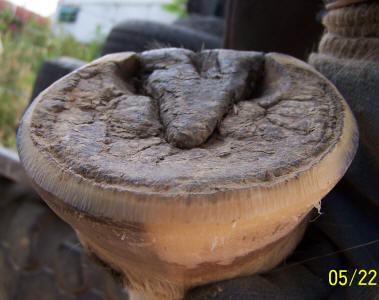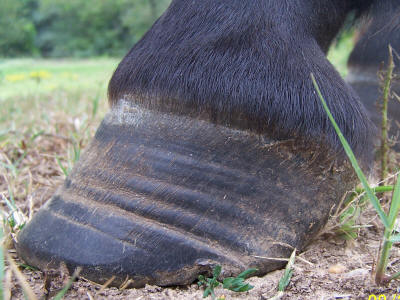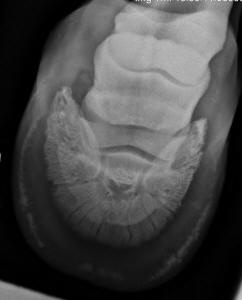
Why Does My Horse Have a Thin Sole?
Horseback Magazine
6-10-2013
Pete Ramey
In last month’s article, I discussed methods of
estimating sole thickness. If you find that your horse has a thin sole, the next
obvious question will be “why?”
Over-Trimming
First, be sure that no one is excessively trimming the
sole. Sure, there is a time and place to remove or exfoliate excess sole tissue,
but not on a horse with a thin sole—seems
obvious, yet this is a very common problem. In domestic horses, the coffin bone
often sinks to a lower-than-normal position within the hoof capsule over time.
When this has occurred, the overall hoof capsule-length will seem “too long.”
This leads many people to over-thin the sole in an attempt to make the hoof
capsule-length seem more normal. It is possible to reverse this “sunken”
condition, but meanwhile it is a serious mistake to shorten the hoof from the
bottom so that the sole is less than 1/2 to 5/8 inches-thick.

This
horse moves well, but has suffered from long-term “subclinical” laminitis from
excess pasture and feed—the walls are flared and the sole is thin. Many
practitioners were taught to always remove the layer of “dead” or exfoliating
sole visible in the photo, leaving a clean, smooth post-trim finish. But since
this horse has a thin sole—even with the crusty layer of dead sole present—it
should not be “cleaned up,” as this would make the situation more dangerous for
the horse. Photo reprinted from the book Care and Rehabilitation of the
Equine Foot, P. Ramey.
General Nutrition
Most horses are (and should be) getting most of their
nutrition from grass and hay. Nutrient levels in this forage vary, depending on
many factors—region, season, growing conditions, etc. Horses living on
free-choice grass and hay are usually getting inadequate levels of some
nutrients, ideal levels of some nutrients, and an excess of some nutrients. To
make up for this problem, horse owners tend to throw salt and mineral blocks out
for the horses, provide daily feed concentrates, and perhaps additional mineral
supplements. The tradition is perhaps “good
enough” for most horses, but often leaves holes in the nutrition profile or
dangerous excesses in some nutrients.
When the horse is “missing something,” the body wisely
provides for the most important functions first—the ones that sustain life and
fight disease. The skin gets the
leftovers. This means that nutritional deficiency or imbalances can lead to thin
soles (and most other problems with skin, coat and hooves).
So the first thing I do when I see these problems in client horses is
start trying to more-scientifically balance the diet. This often means testing
the forage and providing supplements that balance the individual horse’s
nutrition profile.

Flared
or “bell-shaped” walls, ripples in the wall, red stripes or spots in the
wall—these are all possible signs of laminitis and should be taken seriously.
These are much more than “cosmetic flaws.” Photo reprinted from the book Care
and Rehabilitation of the Equine Foot, P. Ramey.
Past or Present
Laminitis
When the laminae are compromised—usually because of excess
sugars in the diet—the outer perimeter of the sole suffers from reduced blood
flow. This can significantly slow down the growth of the sole. Additionally, the
hoof walls in laminitic horses tend to separate from the bone, bending outward
from their protective position around the sole. This loss of protection causes
increased wear to the sole. The result of these two simultaneous factors: most
laminitic horses, even mild cases, have dangerously thin soles.
If this condition is quickly reversed by veterinary
intervention, competent farrier work and adequate changes to the diet, the horse
can usually re-grow a perfect foot
including a thick sole. However, if the situation is allowed to continue, over
time, the coffin bone will remodel—losing mass around the outer perimeter and
often developing a “ski-tip”-shape to the profile of the bone. Once this
remodeling occurs, it is very common for horses to develop a permanent reduction
of sole growth. This is just one more reason why “mild” laminitic symptoms—wall
flare, rippled walls, shelly walls, red streaks, mild seasonal lameness—should
never be ignored. An ounce of prevention
is worth a ton of cure.

Insert Photo
4ramey3. Caption: This is a radiograph of a
horse with long-term “sub-clinical” laminitis (this means that, for years, no
one noticed except the horse). When the outer perimeter of the coffin bone loses
mass and/or becomes wavy or
fuzzy, it is common that the horse
will have a difficult time growing a healthy sole—permanently. This is why it is
so important to take action (dietary changes) when you first notice the
slightest indicators of laminitis. Photo reprinted from the book Care and
Rehabilitation of the Equine Foot, P. Ramey.
Environment
The ground the horse lives and works on has a significant
effect on sole quality and thus thickness. If a horse lives in a soft, wet stall
most of the time, the sole will be soft and weak. This is simple adaptation that
would allow the sole to wear and exfoliate naturally under these conditions. If,
however, this horse is suddenly thrust into a more abrasive environment and
asked to perform, the sole can wear away too quickly. So it is best for the
horse to, 1) dry up and add abrasion to the living environment, and 2) protect
the soles (boots, shoes, etc.) during work and/or increases in activity or load.
It really helps the sole (and the horse’s feet in general)
to vary the living terrain as much as possible. Add coarse gravel to
high-traffic or muddy areas, add pea gravel to shady hangout spots, provide
hard-packed areas, soft areas—just “mix it up” the best you can on your
property. The resulting stimulation grows a better sole and packs it into dense
callus.
Genetics
As I have discussed in previous articles, genetics are
always a factor to some extent. But they are too often used as a scapegoat—they
give people an excuse for not doing everything they can to optimize the
situation. For instance, thoroughbreds may inherently tend to have a thinner
sole than working-stock quarter horses, but fewer thoroughbreds have a chance to
grow the very-best sole they could grow—their genetics are only one of many
factors. I have seen thoroughbreds
raised outdoors in abrasive terrain, and they tend to grow very nice feet in
these conditions—and the flip-side—I have seen nice working-stock quarter horses
that were pampered indoors. Guess what their feet tend to look like?
In my experience, the most important genetic factor
affecting sole thickness is the “thrifty gene.”
The most efficient “easy keeper” in the herd is most likely to be the one
that gets laminitis, and thus the long- or short-term thin sole problems already
discussed. But again, it is not the horse’s fault if he is fed more than he
needs.
Hoof Protection
Whatever the cause of the thin soles, it is critical that
you protect the thin-soled horse from bruising and excess abrasion during work,
exercise and from hard or rocky terrain. Sole health is one of the reasons I
like hoof boots so much. They allow barefoot turnout to optimize stimulation,
growth and callusing of the sole, and then you can boot the horse for complete
protection during work and trips to harsher terrain. But whatever you
use—synthetic or traditional shoes, clogs, casts, epoxies—protecting thin soles
is essential. You should never expect a
thin sole to do the job of protecting the sensitive internal structures of the
foot. At the same time, though, don’t get so caught up in “protection” that you
forget that you may be able to really fix the situation with simple changes to
the horse’s care.